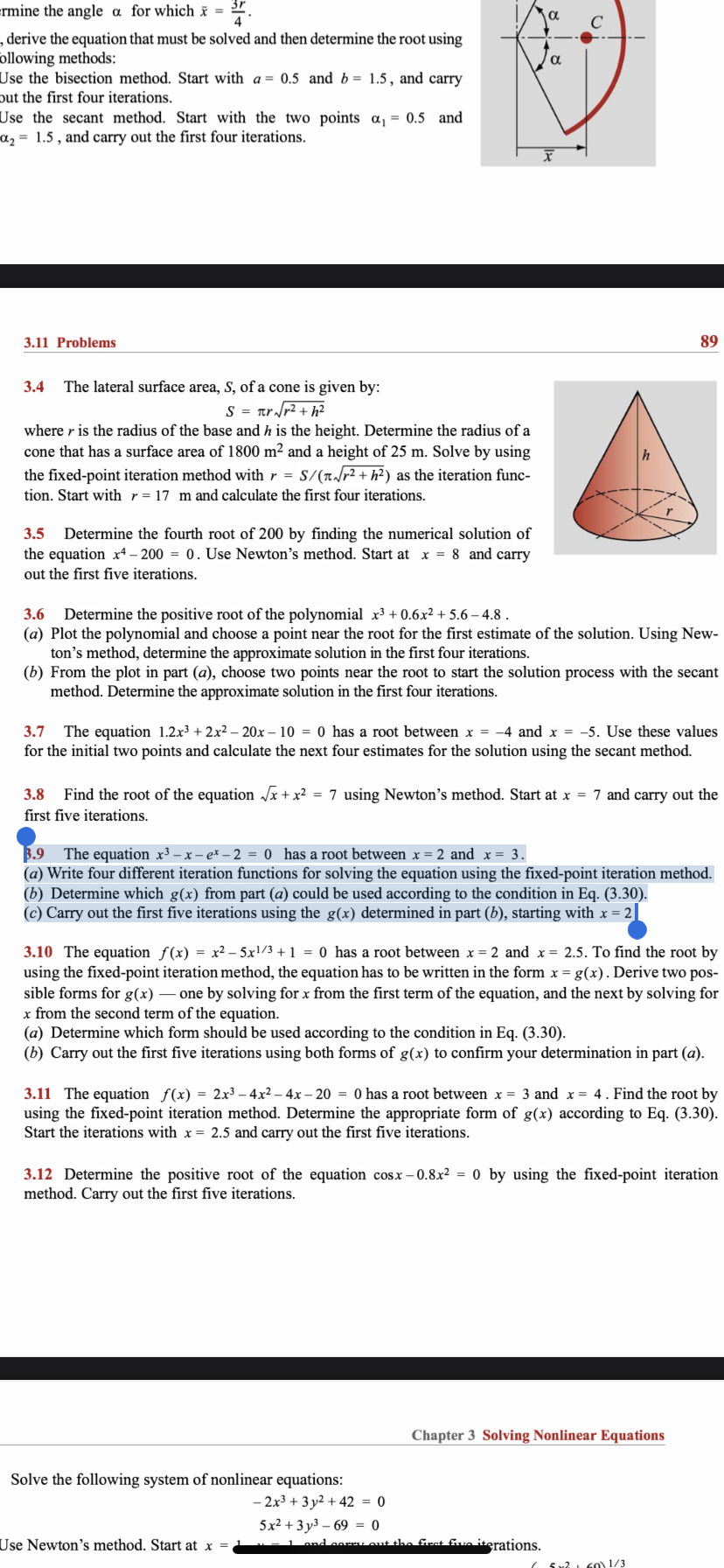3.9 The equation x³ − x−e³ −2 = 0 has a root between x = 2 and x = 3. (a) Write four different iteration functions for solving the equation using the fixed-point iteration method. (b) Determine which g(x) from part (a) could be used according to the condition in Eq. (3.30). (c) Carry out the first five iterations using the g(x) determined in part (b), starting with x = 2||
3.9 The equation x³ − x−e³ −2 = 0 has a root between x = 2 and x = 3. (a) Write four different iteration functions for solving the equation using the fixed-point iteration method. (b) Determine which g(x) from part (a) could be used according to the condition in Eq. (3.30). (c) Carry out the first five iterations using the g(x) determined in part (b), starting with x = 2||
Advanced Engineering Mathematics
10th Edition
ISBN:9780470458365
Author:Erwin Kreyszig
Publisher:Erwin Kreyszig
Chapter2: Second-order Linear Odes
Section: Chapter Questions
Problem 1RQ
Related questions
Question

Transcribed Image Text:rmine the angle a for which x =
, derive the equation that must be solved and then determine the root using
ollowing methods:
3r
Use the bisection method. Start with a= 0.5 and b = 1.5, and carry
out the first four iterations.
Use the secant method. Start with the two points a₁ = 0.5 and
a₂ 1.5, and carry out the first four iterations.
3.11 Problems
3.4 The lateral surface area, S, of a cone is given by:
S = πr√√r²+h²
where r is the radius of the base and h is the height. Determine the radius of a
cone that has a surface area of 1800 m² and a height of 25 m. Solve by using
the fixed-point iteration method with r = S/(√√²+h²) as the iteration func-
tion. Start with r = 17 m and calculate the first four iterations.
3.5 Determine the fourth root of 200 by finding the numerical solution of
the equation x4-200= 0. Use Newton's method. Start at x = 8 and carry
out the first five iterations.
3.6 Determine the positive root of the polynomial x³ +0.6x² +5.6-4.8.
(a) Plot the polynomial and choose a point near the root for the first estimate of the solution. Using New-
ton's method, determine the approximate solution in the first four iterations.
(b) From the plot in part (a), choose two points near the root to start the solution process with the secant
method. Determine the approximate solution in the first four iterations.
3.7 The equation 1.2x³ + 2x²-20x-10 = 0 has a root between x = -4 and x = -5. Use these values
for the initial two points and calculate the next four estimates for the solution using the secant method.
3.8 Find the root of the equation √√x+x²= 7 using Newton's method. Start at x = 7 and carry out the
first five iterations.
α
3.9 The equation x³ − x −e* − 2 = 0 has a root between x = 2 and x = 3.
(a) Write four different iteration functions for solving the equation using the fixed-point iteration method.
(b) Determine which g(x) from part (a) could be used according to the condition in Eq. (3.30).
(c) Carry out the first five iterations using the g(x) determined in part (b), starting with x = 2
3.10 The equation f(x) = x² - 5x¹/3 + 1 = 0 has a root between x = 2 and x = 2.5. To find the root by
using the fixed-point iteration method, the equation has to be written in the form x = g(x). Derive two pos-
sible forms for g(x) - one by solving for x from the first term of the equation, and the next by solving for
x from the second term of the equation.
(a) Determine which form should be used according to the condition in Eq. (3.30).
(b) Carry out the first five iterations using both forms of g(x) to confirm your determination in part (a).
89
3.11 The equation f(x) = 2x³-4x²-4x-20 = 0 has a root between x = 3 and x = 4. Find the root by
using the fixed-point iteration method. Determine the appropriate form of g(x) according to Eq. (3.30).
Start the iterations with x = 2.5 and carry out the first five iterations.
Solve the following system of nonlinear equations:
Use Newton's method. Start at x =
3.12 Determine the positive root of the equation cosx-0.8x² = 0 by using the fixed-point iteration
method. Carry out the first five iterations.
-2x³ + 3y² +42 = 0
5x² + 3y³69 = 0
Chapter 3 Solving Nonlinear Equations
1 and carry out the first five iterations.
5x260) 1/3
Expert Solution
This question has been solved!
Explore an expertly crafted, step-by-step solution for a thorough understanding of key concepts.
Step by step
Solved in 3 steps with 3 images

Recommended textbooks for you

Advanced Engineering Mathematics
Advanced Math
ISBN:
9780470458365
Author:
Erwin Kreyszig
Publisher:
Wiley, John & Sons, Incorporated

Numerical Methods for Engineers
Advanced Math
ISBN:
9780073397924
Author:
Steven C. Chapra Dr., Raymond P. Canale
Publisher:
McGraw-Hill Education

Introductory Mathematics for Engineering Applicat…
Advanced Math
ISBN:
9781118141809
Author:
Nathan Klingbeil
Publisher:
WILEY

Advanced Engineering Mathematics
Advanced Math
ISBN:
9780470458365
Author:
Erwin Kreyszig
Publisher:
Wiley, John & Sons, Incorporated

Numerical Methods for Engineers
Advanced Math
ISBN:
9780073397924
Author:
Steven C. Chapra Dr., Raymond P. Canale
Publisher:
McGraw-Hill Education

Introductory Mathematics for Engineering Applicat…
Advanced Math
ISBN:
9781118141809
Author:
Nathan Klingbeil
Publisher:
WILEY

Mathematics For Machine Technology
Advanced Math
ISBN:
9781337798310
Author:
Peterson, John.
Publisher:
Cengage Learning,

